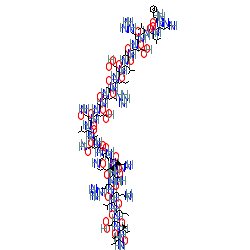GtoPdb is requesting financial support from commercial users. Please see our sustainability page for more information.
|
Compound class:
Peptide
Ligand Activity Visualisation ChartsThese are box plot that provide a unique visualisation, summarising all the activity data for a ligand taken from ChEMBL and GtoPdb across multiple targets and species. Click on a plot to see the median, interquartile range, low and high data points. A value of zero indicates that no data are available. A separate chart is created for each target, and where possible the algorithm tries to merge ChEMBL and GtoPdb targets by matching them on name and UniProt accession, for each available species. However, please note that inconsistency in naming of targets may lead to data for the same target being reported across multiple charts. ✖ |
|
|||||||||||||||||
| References |
|
1. Dautzenberg FM, Py-Lang G, Higelin J, Fischer C, Wright MB, Huber G. (2001)
Different binding modes of amphibian and human corticotropin-releasing factor type 1 and type 2 receptors: evidence for evolutionary differences. J Pharmacol Exp Ther, 296 (1): 113-20. [PMID:11123370] |
|
2. Palchaudhuri MR, Wille S, Mevenkamp G, Spiess J, Fuchs E, Dautzenberg FM. (1998)
Corticotropin-releasing factor receptor type 1 from Tupaia belangeri--cloning, functional expression and tissue distribution. Eur J Biochem, 258 (1): 78-84. [PMID:9851694] |
|
3. Perrin MH, Sutton SW, Cervini LA, Rivier JE, Vale WW. (1999)
Comparison of an agonist, urocortin, and an antagonist, astressin, as radioligands for characterization of corticotropin-releasing factor receptors. J Pharmacol Exp Ther, 288 (2): 729-34. [PMID:9918582] |
|
4. Rivier J, Gulyas J, Kirby D, Low W, Perrin MH, Kunitake K, DiGruccio M, Vaughan J, Reubi JC, Waser B et al.. (2002)
Potent and long-acting corticotropin releasing factor (CRF) receptor 2 selective peptide competitive antagonists. J Med Chem, 45 (21): 4737-47. [PMID:12361401] |
|
5. Rivier JE, Rivier CL. (2014)
Corticotropin-releasing factor peptide antagonists: design, characterization and potential clinical relevance. Front Neuroendocrinol, 35 (2): 161-70. [PMID:24269930] |






